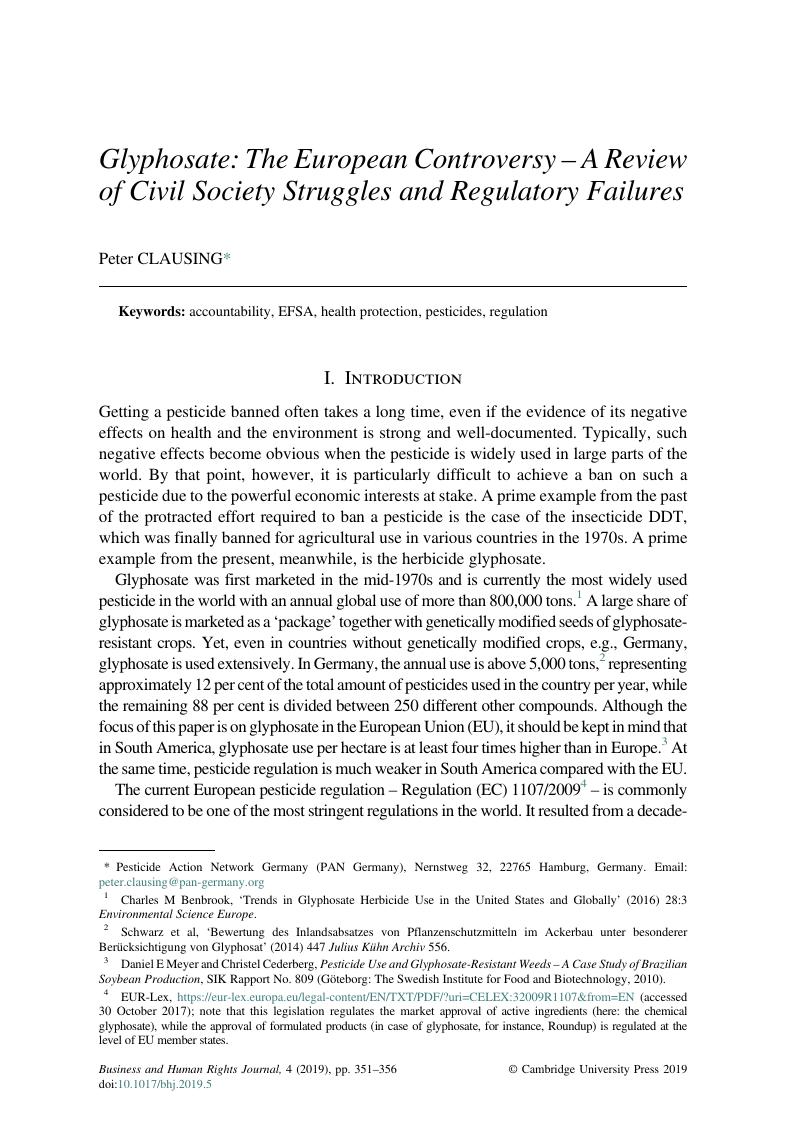No CrossRef data available.
Article contents
Glyphosate: The European Controversy – A Review of Civil Society Struggles and Regulatory Failures
Published online by Cambridge University Press: 20 June 2019
Abstract

- Type
- Developments in the Field – Special Issue on Agribusiness and Accountability
- Information
- Copyright
- © Cambridge University Press 2019
References
1 Benbrook, Charles M, ‘Trends in Glyphosate Herbicide Use in the United States and Globally’ (2016) 28:3 Environmental Science Europe.CrossRefGoogle ScholarPubMed
2 Schwarz, et al, ‘Bewertung des Inlandsabsatzes von Pflanzenschutzmitteln im Ackerbau unter besonderer Berücksichtigung von Glyphosat’ (2014) 447 Julius Kühn Archiv 556.Google Scholar
3 Daniel E Meyer and Christel Cederberg, Pesticide Use and Glyphosate-Resistant Weeds – A Case Study of Brazilian Soybean Production, SIK Rapport No. 809 (Göteborg: The Swedish Institute for Food and Biotechnology, 2010).
4 EUR-Lex, https://eur-lex.europa.eu/legal-content/EN/TXT/PDF/?uri=CELEX:32009R1107&from=EN (accessed 30 October 2017); note that this legislation regulates the market approval of active ingredients (here: the chemical glyphosate), while the approval of formulated products (in case of glyphosate, for instance, Roundup) is regulated at the level of EU member states.
5 A ‘hazard’ is an intrinsic characteristic of a chemical (e.g., it is carcinogenic), whereas a ‘risk’ involves an assessment of the likelihood that this characteristic will affect human health.
6 International Covenant on Economic, Social and Cultural Rights, Article 12.
7 Michael Antoniou et al, ‘Roundup and Birth Defects. Is the Public Being Kept in the Dark?’ Earth Open Source (2011), http://earthopensource.org/wp-content/uploads/RoundupandBirthDefectsv5.pdf (accessed 30 October 2015); Krüger, Monika et al, ‘Detection of Glyphosate in Malformed Piglets’ (2014) 4:5 Journal of Environmental Analytics and Toxicology 230.Google Scholar
8 Umweltbundesamt, ‘Glyphosat’ (05 February 2016), http://www.umweltbundesamt.de/themen/chemikalien/pflanzenschutzmittel/glyphosat (accessed 30 October 2015).
9 Jayasumana, Channa et al, ‘Drinking Well Water and Occupational Exposure to Herbicides is Associated with Chronic Kidney Disease in Padavi-Sripura, Sri Lanka’ (2015) 14:6 Environmental Health 1.Google Scholar
10 IARC, ‘Some Organophosphate Insecticides and Herbicides’, 112 IARC Monographs (Lyon, France: World Health Organization, 2017).CrossRefGoogle ScholarPubMed
11 Guyton, Kathryn Z et al, ‘Carcinogenicity of Tetrachlorvinphos, Parathion, Malathion, Diazinon, and Glyphosate’ (2015) 16:5 Lancet Oncology 490.Google Scholar
12 For example, Portier, Christopher J et al, ‘Differences in the Carcinogenic Evaluation of Glyphosate Between the International Agency for Research on Cancer (IARC) and the European Food Safety Authority (EFSA)’ (2016) 70:8 Journal of Epidemiology and Community Health 741.CrossRefGoogle ScholarPubMed
13 RMS Germany, ‘Renewal Assessment Report Glyphosate’, Addendum 1 to RAR, Assessment of IARC Monographs Volume 112 (2015): Glyphosate’ (31 August 2015), http://gmwatch.org/files/Renewal_Assessment_Report_Glyphosate_Addendum1_RAR.pdf (accessed 30 October 2017).
14 Peter Clausing, Claire Robinson and Helmut Burtscher-Schaden, ‘Glyphosate and Cancer: Authorities Systematically Breach Regulations’ (2018) Journal of Epidemiology and Community Health, EPub ahead of print.
15 Peter Clausing, ‘The Glyphosate Renewal Assessment Report. An Analysis of Gaps and Deficiencies’ (2015), http://www.pan-germany.org/download/Glyphosat-Studie_Campact_PAN_korrigiert.pdf (accessed 5 April 2018).
16 Josef Unterweger, ‘Statement of Facts’ (2 March 2016), https://www.welt-ernaehrung.de/wp-content/uploads/2017/10/Strafanzeige-Glyphosate-Berlin-160302_en.pdf (accessed 31 October 2017).
17 EFSA, ‘Conclusion on the Peer Review of the Pesticide Risk Assessment of the Active Substance Glyphosate’ (2015) 13:11 EFSA Journal 4302.CrossRefGoogle Scholar
18 According to EU rules, a ‘qualified’ majority of member countries (i.e., more than 14 countries) representing at least 65 per cent of the population need to support the move.
19 EUR-Lex, https://eur-lex.europa.eu/legal-content/EN/TXT/PDF/?uri=CELEX:32008R1272&from=EN (accessed 30 October 2017); ECHA’s assessment procedure is explained in Clausing, note 14.
20 ECHA, ‘Opinion Proposing Harmonised Classification and Labelling at EU Level of Glyphosate’ (17 March 2017), https://echa.europa.eu/documents/10162/2f8b5c7f-030f-5d3a-e87e-0262fb392f38 (accessed 4 April 2018).
21 Clausing, note 14.
22 European Commission, ‘Summary Report of the Standing Committee on Plants, Animals, Food and Feed: Section Phytopharmaceuticals - Plant Protection Products - Legislation’ (25 October 2017), https://ec.europa.eu/food/sites/food/files/plant/docs/sc_phyto_20171025_pppl_summary.pdf (accessed 31 October 2017).
23 International Monsanto Tribunal, ‘Tribunal’, http://www.monsanto-tribunal.org/How (accessed 30 October 2017); Unterweger, note 16.
24 Helmut Burtscher-Schaden, Peter Clausing and Claire Robinson, ‘Glyphosate and Cancer: Buying Science’ (March 2017), http://www.pan-germany.org/download/Glyphosate_buying_science-EN.pdf (accessed 30 October 2017).
25 Euractiv, ‘More than 1.3 Million Demand EU Glyphosate Ban’ (23 October 2017), http://www.euractiv.com/section/agriculture-food/news/more-than-1-3-million-demand-eu-glyphosate-ban/ (accessed 30 October 2017).


